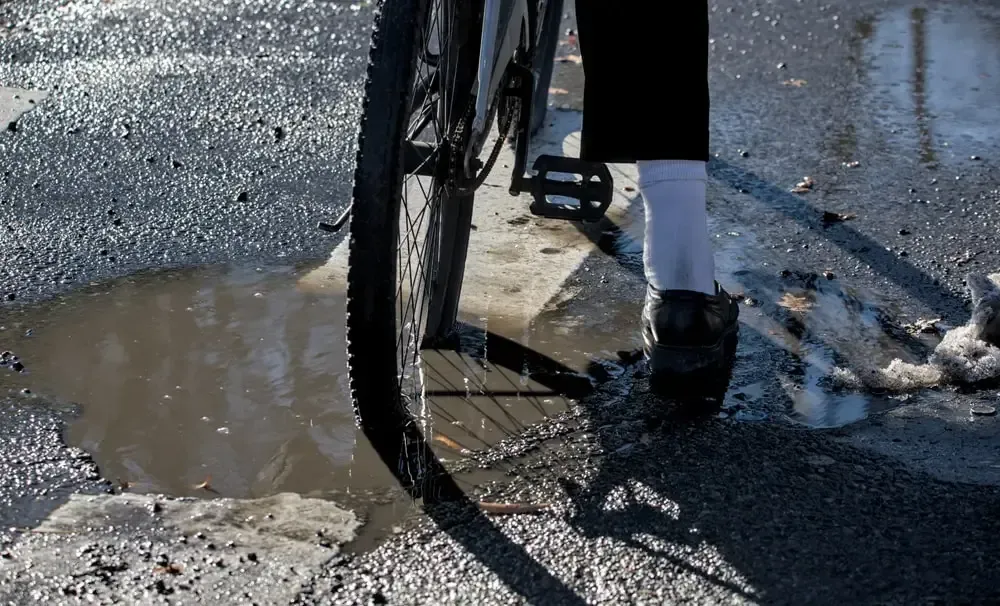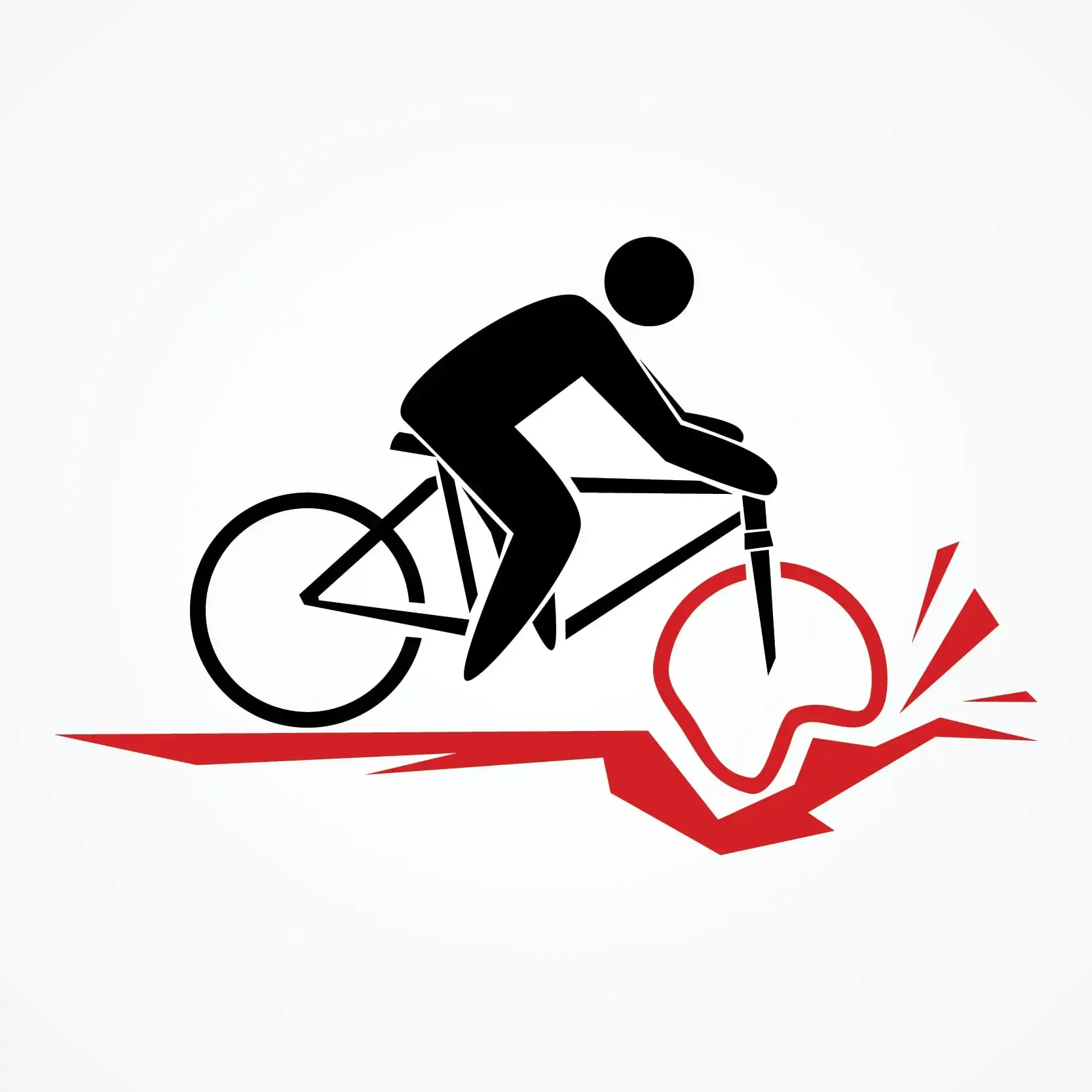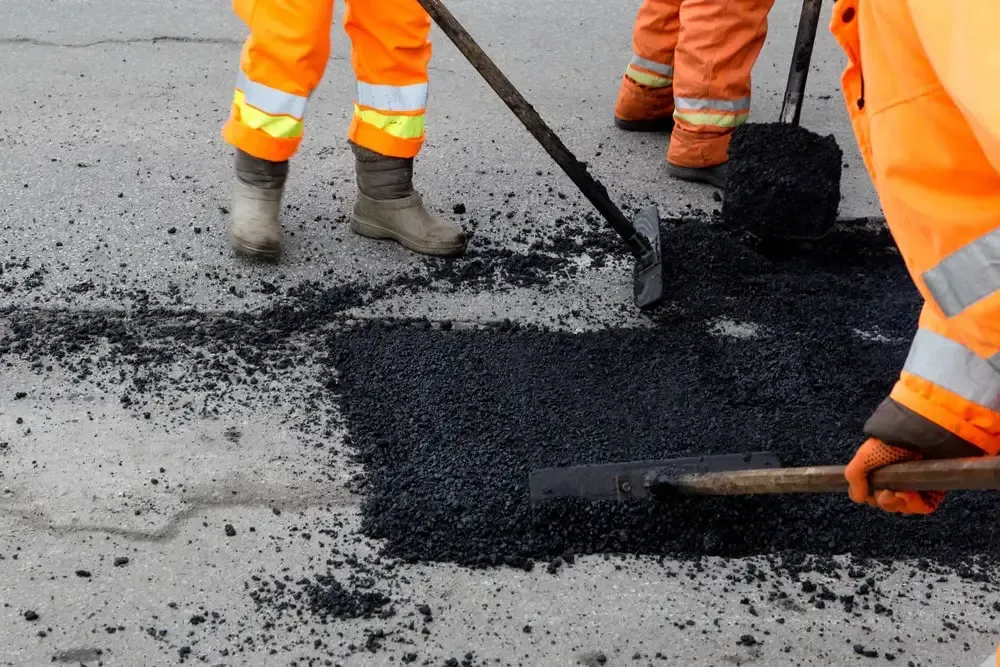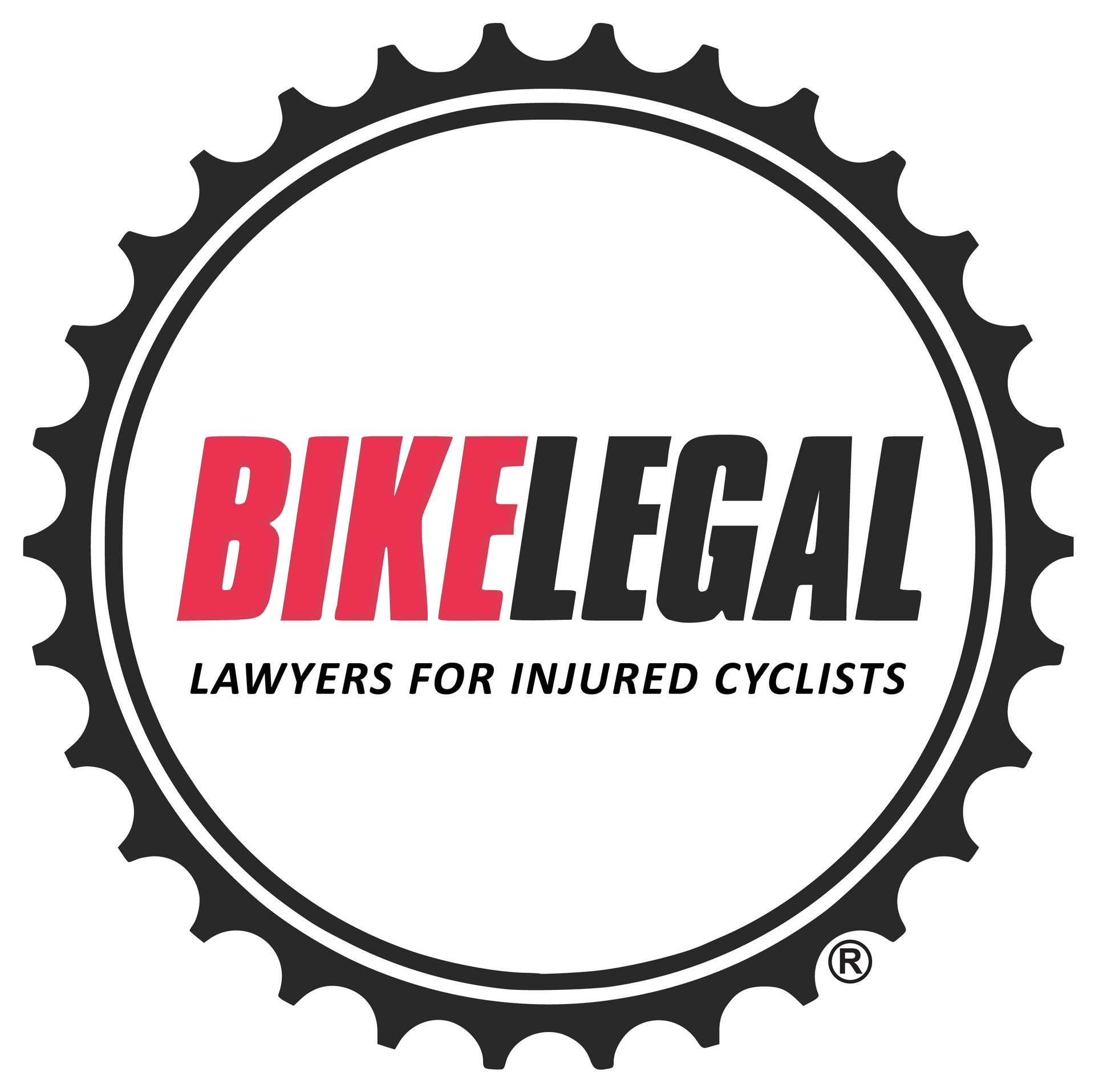Essential Guide to Cyclist Pothole Claims: Your Path to Compensation
Follow us on
social media!
Pothole-related bicycle crashes often lead to serious injuries, medical expenses, and bike damage. Cyclists may be entitled to compensation, but it’s crucial to understand who is responsible for road maintenance, how to report hazards, and what steps to take to protect your legal rights.
Knowing how to respond after a crash can mean the difference between bearing the costs alone or securing the compensation you deserve.
What Are Potholes and How Do They Occur?

- What Are Potholes? Potholes are holes or depressions in the road surface that form when the pavement weakens over time. They’re a common road hazard, especially on older or poorly maintained roads.
- How Do Potholes Occur? Potholes develop from a combination of weather (rain, freezing temperatures), heavy traffic, and poor road maintenance. Faulty or delayed repairs can also make roads more vulnerable to potholes.
- Why Are Potholes Dangerous for Cyclists? Potholes can cause sudden crashes, leading to serious injuries like broken bones and head trauma. They can also damage bikes and gear, resulting in costly repairs or replacements.
According to the National Highway Traffic Safety Administration (NHTSA), approximately 13% of bicycle accidents result from road hazards, including potholes, uneven pavement, and debris. In urban areas, where traffic is heavier and road maintenance is often delayed, cyclists are more than twice as likely to encounter hazardous road conditions that can lead to crashes.
Bicycle crashes caused by road defects account for thousands of emergency room visits each year, often involving serious injuries such as broken bones, head trauma, and spinal injuries.
Common Injuries and Damages Caused by Potholes
Pothole crashes can cause a wide range of injuries, from minor cuts to life-changing trauma:
- Broken bones in wrists, arms, or collarbones from bracing a fall
- Head trauma or concussions, even with a helmet
- Spinal injuries that may lead to chronic pain or disability
- Lacerations and road rash that risk infection
- Dental injuries, such as broken teeth or jaw damage
These crashes also leave emotional impacts, like anxiety or PTSD, which can cause cyclists to avoid riding, lose confidence in road safety, or experience emotional distress from dealing with injuries and financial strain.
Financial losses from pothole accidents can add up quickly:
- Bike repairs or replacement for damaged wheels, frames, or components
- Lost gear like helmets, clothing, and lights
- Medical expenses, including hospital visits, treatment and rehabilitation
- Lost wages from time off work
- Ongoing costs like transportation if riding is no longer an option
How to Determine If You Have a Pothole Bicycle Accident Case

Not every pothole crash leads to personal injury or a valid legal claim, but you may be entitled to compensation if negligence played a role in your accident.
Was Negligence Involved?
A pothole accident case in court often hinges on whether someone responsible for maintaining the road acted negligently. Negligence typically occurs when a city, county, or property owner:
- Failed to repair a known hazard in a reasonable timeframe.
- Ignored reports about the pothole from the public.
- Did not post warning signs to alert cyclists of road defects.
If the pothole had been previously reported or should have been identified during routine inspections, and no steps were taken to repair it, you may have a case for liability of unsafe road conditions.
Were You Injured, or Was Your Bike Damaged?
For a claim to be valid, you must show that the accident happened and caused actual harm, such as:
- Medical expenses due to injuries.
- Property damage such as a damaged bicycle and other equipment and cycling gear
- Lost wages due to time off work.
Even if your injuries seem minor, documenting them thoroughly can help strengthen your case. Keep all records of medical treatment, bike repairs, and any other related costs.
Who Is Responsible for Maintaining the Road?

Determining who is responsible for road maintenance is a critical and complex step in your claim. The liable party depends on the exact location of the road where the pothole is located:
- City and/or county governments are responsible for public streets and/or bike lanes.
- State transportation agencies maintain state roads and highways.
- Private property owners are responsible for parking lots, driveways, and private roads.
Identifying the correct party is essential, as government claims often have short filing deadlines and specific procedures to follow.
Filing a pothole-related claim can be challenging, especially when dealing with government entities. A bicycle accident attorney can help you with the following:
- Identify the liable party and gather evidence to prove negligence.
- File your claim within deadlines, which are often shorter for government claims.
- Negotiate for fair compensation to cover your medical bills, bike repairs, and other losses.
If you believe negligence caused serious damage in your accident, it's worth seeking legal advice to protect your rights and explore your options for pothole injury compensation.
Step-by-Step Guide: What to Do After a Pothole Accident
Taking the right steps after a pothole-related bicycle accident can strengthen your claim and help you get the compensation you deserve.
- Seek Medical Attention Immediately: Your health comes first. Get checked by a doctor, even if injuries seem minor.
- Gather Evidence: Take photos of the pothole (use a coin or object for scale), your injuries, and damaged bike gear. Document any nearby signage or roadwork.
- Identify Witnesses: Collect names and contact information from anyone who saw the accident.
- Report the Pothole: Report the crash to the local law enforcement jurisdiction. File a complaint with the city, county, local authority or state agency responsible for the road and request confirmation of your report.
- Document Expenses: Keep track of medical bills, bike repair costs, and lost wages from time off work.
- Consult a bicycle accident lawyer: Contact a cycling accident lawyer to help determine liability, file your claim, and pursue compensation. Remember, these types of government claims typically have restrictive and complex filing requirements, and it is best to at least discuss your options with a reputable bicycle accident attorney.
Read More: What to Do After a Bicycle Accident
Identifying Responsible Parties
Common sources of negligence and other road defects include:
- Municipalities: Responsible for maintaining public roads and fixing potholes promptly.
- Contractors or Utility Companies: These entities may be liable for incomplete or improper road repairs that create hazards.
- Water, Electrical, or Construction Companies: Can be responsible if work zones lack proper signage or create unsafe conditions.
- Multiple Parties: In some cases, more than one entity may share responsibility for the hazard. It is essential to identify all liable parties in order to properly file and pursue your claim.
Evidence Cyclists Need to Strengthen Their Claim
To improve your chances of a successful claim, gather the following evidence:
- Photos of the pothole: Include width, depth, and location measurements.
- Medical records: Document all injuries and treatments.
- Witness statements: Collect names and contact information from anyone who saw the crash.
- Police report: File a police report and obtain the report number and the officer's contact info.
- Expense documentation: Track all costs, including medical bills, lost wages, and damaged items.
- Public record of the pothole: Report the hazard to the appropriate municipal authority to establish a record.
Compensation Cyclists May Be Entitled To
If a pothole-related cycling accident caused injuries and financial losses, cyclists may be eligible for the following types of compensation:
- Medical expenses: Covers immediate treatment, hospital visits, surgeries, medications, and possibly long-term rehabilitation.
- Lost wages: Reimbursement for time off work due to injuries.
- Reduced earning capacity: Compensation if your injuries prevent you from returning to your previous job or limit your future earning potential.
- Pain and suffering: Damages for physical pain, emotional distress, trauma, or loss of enjoyment of life.
- Repair or replacement costs: Covers the cost of fixing or replacing your damaged bike, helmet, clothing, and other gear.
Why Consulting a Bicycle Accident Attorney is Critical for Pothole Bicycle Crashes
Filing a claim for a pothole-related bicycle crash can be overwhelming, especially when government agencies are involved. Claims against cities or counties come with unique challenges, including strict deadlines, legal protections for government entities, and strict requirements to prove negligence.
Here’s how a knowledgeable bicycle accident attorney can make the difference:
1) Governmental immunity protections
Many government agencies are protected from liability unless negligence can be clearly proven. This means you must show that the agency responsible for the road failed to repair the pothole after being made aware of it.
How a lawyer helps: An attorney knows how to gather evidence that proves negligence, such as prior complaints and inspection records. They also understand the legal exceptions to immunity and can argue why the government should be held accountable.
2) Proving knowledge of the hazard
To succeed in your claim, you need to show that the responsible party knew or should have known about the pothole and failed to act. This requires proving that the hazard was reported or that the agency’s regular inspections should have identified the issue.
How a lawyer helps: A lawyer can investigate whether the pothole was previously reported and access government maintenance records. They also know what documentation is required to prove the municipality’s failure to act.
3) Burden of proof
There must be proof that the pothole was dangerous enough to cause the crash and that the responsible party didn’t take reasonable steps to maintain the road. This can be a difficult standard to meet without legal experience.
How a lawyer helps: An attorney can build a strong case by gathering photos, medical records, and expert testimony to prove that the road condition caused your injuries. They’ll also know how to counter any arguments that try to shift the blame onto you.
4) Inspection records
Accessing road maintenance and inspection records is often necessary to prove that the responsible party failed to maintain the road properly. However, these records are not always easy to obtain.
How a lawyer helps: A bicycle accident attorney will know how to request these documents through formal channels, such as public records request or through the subpoena process. They can also ensure the records are used effectively to prove your claim.
5)Statute of Limitations
Statutes of limitations vary by state and are often shorter when filing cyclist pothole claims against government entities — sometimes as little as 30 to 180 days. Deadlines for government claims are stricter than for private property cases, so it’s important to act fast.
How a lawyer helps: A bicycle accident lawyer will know the deadlines and take care of the filing so you don’t risk losing your chance of compensation.
Reporting the Pothole
Reporting a pothole is essential to create a public record that can support your claim. You can report potholes by:
- Using local apps like 311 or municipal websites.
- Filing a report with the state transportation department if it's a major road or highway.
- Encouraging others in your community to report hazards to increase attention to dangerous areas.
Practical Safety Tips for Cyclists to Avoid Pothole Accidents
Cyclists can reduce the risk of pothole-related crashes by taking these precautions:
- Scan the road ahead: Watch for dark spots, cracks, and puddles that may hide potholes.
- Use proper lighting and reflective gear: Ensure you're visible to drivers and can see road hazards clearly.
- Maintain tire inflation: Keep tires properly inflated and consider using puncture-resistant tires to reduce damage from rough surfaces.
- Practice emergency maneuvers: Learn how to bunny-hop, swerve safely, or brake quickly to avoid unexpected hazards.
- Communicate in group rides: When cycling with others, call out and point to hazards to keep everyone safe.
Advocating for Safer Roads
Cyclists can play an active role in promoting safer road conditions:
- Report hazards proactively: Create a public record by reporting potholes and other road dangers as soon as they’re noticed.
- Support advocacy groups: Join organizations that push for better road maintenance policies and improved cycling infrastructure.
- Engage with local governments: Attend city meetings, submit maintenance requests, and encourage officials to prioritize safer roads for cyclists.
FAQs About Cyclist Pothole Claims
Can I sue if my bicycle crash was caused by a pothole?
Yes, you can sue if your crash was caused by a pothole, especially if the responsible party failed to repair it after being made aware of the hazard. Claims can be filed against government agencies, highway authorities, local authorities, private property owners, or contractors, depending on who maintains the road.
What is the typical deadline for filing a pothole injury claim?
The deadline varies by state. For claims against a government agency, you typically have 30 to 180 days to file a notice of claim. For private property claims, the statute of limitations is usually one to two years, but it varies state by state.
What if the pothole is on private property instead of a public road?
You can file a claim against the property owner if the pothole is on private property. Private property owners are responsible for maintaining safe conditions in parking lots, driveways, and private roads. Their insurance may cover your damages.
How much does it cost to hire a lawyer for a case like this?
Most bike injury lawyers work on a contingency fee basis, meaning you don’t pay anything upfront. The lawyer’s fee is typically a percentage of your settlement or court award, so you only pay if you win your case.
Can I file a claim if I was partially at fault for the accident?
Yes, in most states, you can still claim compensation or file a claim if you were partially at fault. States with comparative negligence laws allow you to make a successful claim and recover compensation based on the percentage of fault assigned to you. However, your compensation may be reduced by your share of the blame. These laws vary state to state.
Cycling accident caused by pothole? Call Bike Legal
If you’ve been injured in a pothole-related crash, Bike Legal can help you navigate the complexities of your claim. Call us at (877) 245-3534 for a free consultation and let us fight for the compensation you deserve. Don’t wait—protect your rights and take action today.


